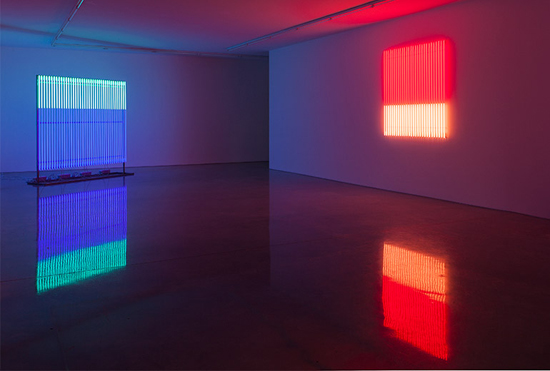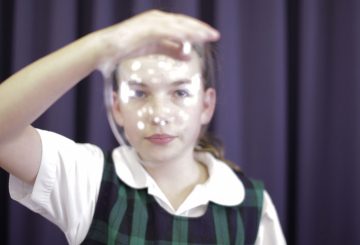From Andrew Frost…
Art works with light sources within them play tricks on the eyes and the mind. Where traditional art media relies almost entirely on the reflective qualities of surfaces, contemporary works such as sculptures, installations and new media works that are in themselves light sources create a dazzling effect where the eye is drawn straight to the light. As various recent exhibitions such as including James Turrell at the National Gallery of Australia, the Museum of Contemporary Art’s current Light Show extravaganza and the Bill Culbert show at the National Art School demonstrated, the use of light as a material also almost inevitably invokes a sense of the religious even where the conceptual idea is based in questions of perception.
The previous gallery blurbs on West Australian artist Brendan van Hek have claimed that the artist’s work has “…emerged from elaborate narratives located in personal history, fiction and social politics.” One might need to do a bit of conceptual excavation to work out exactly how those interests manifest themselves in the work, but on one at level at least, van Hek’s sculptures present an interesting alternative interpretation – while the eye might well be drawn to the neon it’s in the use of reflection as a process of experiencing the work that takes these stunning sculptures to another realm. Located in Sarah Cottier Gallery’s big daylight filled space, the works evolve with the changing intensity of light during the day thanks to the use of mirrors and reflective surfaces in the works, each proposing a landscape, skyscape or part thereof, each reflecting on the other. Van Hek’s work presents the viewer with that rare moment when the studiously conceptual takes off into something much bigger.
Until May 23
Sarah Cottier Gallery, Paddington
Pic: Brendan van Hek, Turn the night to day (installation view), 2015.



Actually, “traditional” artworks rely on the transparency of media as well as their reflective qualities. various forms of glazes and fattening media, such as wax, are all to some degree transparent, giving the lustre and tone to various technical effects such as “splendor.” The idea that only “Art works with light sources within them play tricks on the eyes and the mind,” set against “traditional” art is an entirely artificial binary and poorly informed one at that. Perhaps the final sentence says it all… “the studiously conceptual takes off into something much bigger.” These are not works that in any way deal with philosophy of language or the relationship between affect and words, as in the Joseph Kosuth’s work, and so are not conceptual in any way. While they are formalist in the sense that they deal with the formal aspects of light and colour, their main effect is an appeal to affective capacity in their viewers. The kind of puff piece media marketing lingo used in the description for this show does nothing for the work and muddies the waters for any grasp of contemporary art.
Tom, your determination to find fault with this post is really quite impressive – The Art Life
These are not works that in any way deal with philosophy of language or the relationship between affect and words, as in the Joseph Kosuth’s work, and so are not conceptual in any way.
The place for the conceptual in art didn’t begin or end with Kosuth et al – they simply gave primacy to the concept. Surely in 2015 we can distinguish between historical big C Conceptual art and art that uses concepts. Chill out.